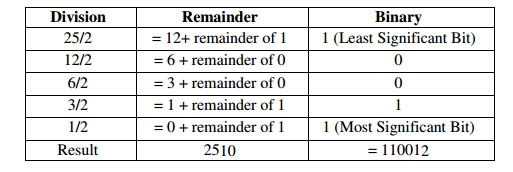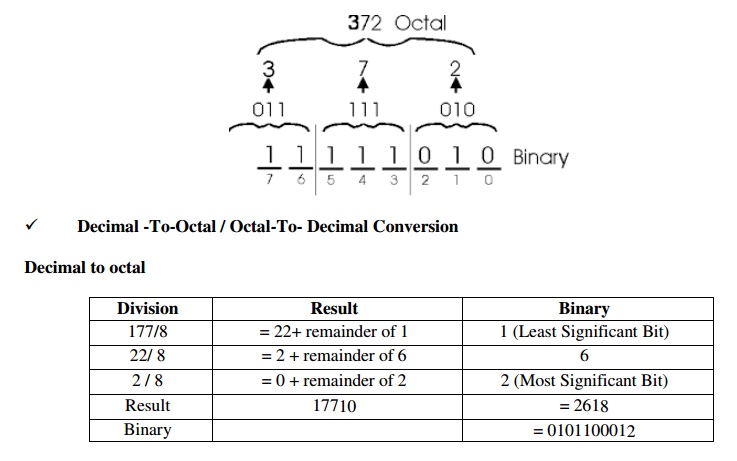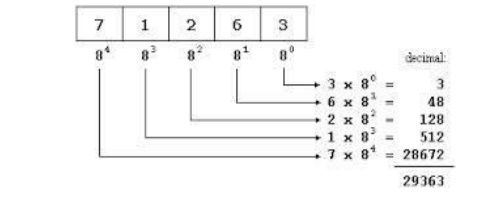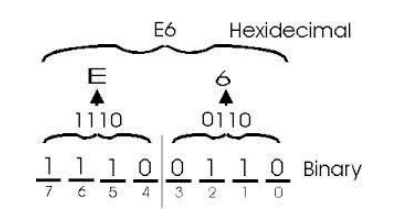Chapter: Digital Principles and System Design : Boolean Algebra and Logic Gates
Review of Number Systems
REVIEW OF NUMBER SYSTEMS
Many number systems are in use in digital
technology. The most common are the decimal, binary, octal, and hexadecimal
systems. The decimal system is clearly the most familiar to us because it is
tools that we use every day.
Types of Number Systems are
1Decimal Number system
2 Binary Number system
3 Octal Number system
4 Hexadecimal Number system
Fig: Types of Number Systems
DECIMAL BINARY OCTAL HEXADECIMAL
0 0000 0 0
1 0001 1 1
2 0010 2 2
3 0011 3 3
4 0100 4 4
5 0101 5 5
6 0110 6 6
7 0111 7 7
8 1000 10 8
9 1001 11 9
10 1010 12 A
11 1011 13 B
12 1100 14 C
13 1101 15 D
14 1110 16 E
15 1111 17 F
Fig:
Number system and their Base value

Decimal system: Decimal system is composed
of 10 numerals or symbols. These 10 symbols are 0, 1, 2, 3, 4, 5, 6, 7,
8, 9. Using these symbols as digits of a number, we can express any quantity.
The decimal system is also called the base-10 system because it has 10 digits.
Even though the decimal system has only 10 symbols, any number of any magnitude
can be expressed by using our system of positional weighting.

Example: 3.1410 , 5210
,102410
Binary System: In the binary system,
there are only two symbols or possible digit values, 0 and 1. This base-2
system can be used to represent any quantity that can be represented in decimal
or other base system.

In digital systems the information that is being processed is
usually presented in binary form. Binary quantities can be represented by any
device that has only two operating states or possible conditions. E.g.. A
switch is only open or closed. We arbitrarily (as we define them) let an open
switch represent binary 0 and a closed switch represent binary 1. Thus we can
represent any binary number by using series of switches.
Binary 1: Any voltage between 2V to 5V Binary 0: Any voltage
between 0V to 0.8V
Not used: Voltage between 0.8V to 2V in 5 Volt CMOS and TTL
Logic, this may cause error in a digital circuit. Today's digital circuits
works at 1.8 volts, so this statement may not hold true for all logic circuits.
Octal System: The octal number system
has a base of eight, meaning that it has eight possible digits: 0,1,2,3,4,5,6,7.

Hexadecimal System: The
hexadecimal system uses base 16. Thus, it has 16 possible digit symbols. It uses
the digits 0 through 9 plus the letters A, B, C, D, E, and F as the 16 digit
symbols.

Code
Conversion
Converting from one code form to another code form is called
code conversion, like converting from binary to decimal or converting from
hexadecimal to decimal.
ü Binary-To-Decimal
Conversion: Any
binary number can be converted to its decimal equivalent simply by summing together the weights of the
various positions in the binary number which contain a 1.

ü Decimal
to binary Conversion:
There are 2 methods:
• Reverse
of Binary-To-Decimal Method
• Repeat
Division
Reverse
of Binary-To-Decimal Method

Repeat Division-Convert decimal to binary: This
method uses repeated division by 2.

üBinary-To-Octal
/ Octal-To-Binary Conversion
Binary to octal
100 111 0102 = (100) (111) (010)2 = 4 7 28
üDecimal
-To-Octal / Octal-To- Decimal Conversion
Decimal to octal

Octal to Decimal

ü Hexadecimal
to Decimal/Decimal to Hexadecimal Conversion Decimal to Hexadecimal

ü
Binary-To-Hexadecimal /Hexadecimal-To-Binary
Conversion
Binary-To-Hexadecimal:
1011
0010 11112 = (1011) (0010) (1111)2 = B 2 F16
Hexadecimal to binary

ü Octal-To-Hexadecimal
Hexadecimal-To-Octal Conversion
·
Convert Octal (Hexadecimal) to Binary first.
·
Regroup the binary number by three bits per group
starting from LSB if Octal is required.
·
Regroup the binary number by four bits per group
starting from LSB if Hexadecimal is required.
Octal to Hexadecimal

Hexadecimal to octal

1’s and 2’s complement
Complements are used in digital computers to
simplify the subtraction operation and for logical manipulation. There are TWO
types of complements for each base-r system: the radix complement and the
diminished radix complement. The first is referred to as the r's complement and
the second as the (r - 1)'s complement, when the value of the base r is
substituted in the name. The two types are referred to as the
2's complement and 1's complement for binary numbers and the 10’s complement a complement
for decimal numbers.
The 1’s complement
of a binary number is the number that results when gewe allchan1’s to zeros and
the zeros to ones.
The 2’s complement is the binary number that
results when we add 1 to the 1’s complem It is used to represent negative
numbers.
2’s complement=1’s complement+1

Ref: 1) A.P Godse & D.A Godse “Digital Electronics”, Technicalpublications, Pune, Revised third edition, 2008. Pg.No:1-17
2) Morris Mano M. and Michael D. Ciletti, “Digital Design”, IV Edition, Pearson Edition 2008.Pg.No:1-8.
Related Topics